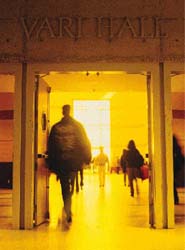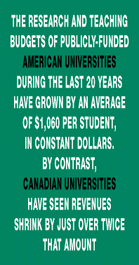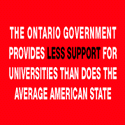 | |
Page: 2
"Questions of access don't just mean questions of affordability," said Ontario premier Mike Harris in a speech to delegates attending last year's Council of Ontario Universities Summit. They don't? Try telling that to someone like Vaughan Secondary School guidance counsellor Bryan Smillie. "A lot of kids want to go away from home to university, but they simply can't afford it even at our school where I would say the majority are middle to upper-middle class," says Smillie. "I think the cost of an education these days really affects accessibility. It affects the kind of choices kids are able to make."
University tuition in Canada increased by 152 per cent during the last 10 years, making the approximate cost of a four-year undergraduate degree at York $50,668 ($12,667 per year for four years, including cost of books, tuition, food, accommodation and transportation).
Scott shares an apartment close to campus with a roommate in order to live frugally. "It's cheaper than living in residence. I couldn't live at home because it's too far to commute," she says. Still, every little bit helps, and Scott says having a York work-study job made her university education that much more accessible.
York student and scholarship winner Shelley Langstaff also knows what it's like to pinch pennies. Langstaff, a single 29-year-old mother of two boys, lived on social assistance while she went back to high school. She saw university as a way of breaking the welfare cycle.
After graduating with a 95 per cent average, Langstaff applied to York and won both an entrance scholarship and the Proctor Scholarship one of the University's most important awards. The two scholarships combined guarantee her $7,800 for each of her four years at York. She estimates, however, that she'll still be $60,000 in debt at the end of her education.
Scott and Langstaff are just two examples of how York is trying to make university more accessible by making it more affordable, through work study programs, service bursaries, awards and scholarships.
York's Academic Plan maintains the University should adopt strategies to actively recruit and enrol the largest possible number and proportion of highly qualified students. But in the spirit of inclusivity and accessibility the Plan states that recruitment, admissions, orientation and support policies must be socially responsible, even as high academic standards are maintained.
Admissions director Lucy Fromowitz (BA '81) says the Academic Plan clearly states York's mission to reach out to individuals with good academic potential. "I think the fact we're in the GTA means we have to reach out to different populations. There are three issues for us: academic excellence, access, and social responsiveness. People tend to see these as three separate categories, but I would argue they are not."
|
|
Continue |
Text Menu
[ Home | Past Issues | Subscriptions | Feedback | Site Map | Search ]

 As governments continue to cut money available for student loans and scholarships, a university education may become the preserve of two groups of students: the rich, and those with scholarships. (There is one other group, however those who must take on huge debtloads because there simply isn't enough grant money to go around.)
As governments continue to cut money available for student loans and scholarships, a university education may become the preserve of two groups of students: the rich, and those with scholarships. (There is one other group, however those who must take on huge debtloads because there simply isn't enough grant money to go around.)
 Consider the case of second year York student Vickie Scott. Coming from a single-parent family, she certainly knows the value of a dollar."My mother couldn't afford to send me, so I'm relying on OSAP loans," she says. Scott entered York with an 85 per cent average. Yet, even with her York work-study job, she estimates she'll end up well over $20,000 in debt. "I earn $500 a month doing office work, but it's money I use to buy all the other life essentials I need after I've finished paying the rent."
Consider the case of second year York student Vickie Scott. Coming from a single-parent family, she certainly knows the value of a dollar."My mother couldn't afford to send me, so I'm relying on OSAP loans," she says. Scott entered York with an 85 per cent average. Yet, even with her York work-study job, she estimates she'll end up well over $20,000 in debt. "I earn $500 a month doing office work, but it's money I use to buy all the other life essentials I need after I've finished paying the rent."
 In her bid to get one foot up on the ladder, however, Langstaff encountered lots of resistance from "the system" and even her own family. The people who didn't stand in her way were some mentor teachers at her Oshawa high school who urged her to apply for a York scholarship. "My family thought I should just get a $7 an hour job and be happy," says Langstaff. "But the system doesn't support you. Sometimes, in fact, you get the feeling they'd like to keep you just where you are."
In her bid to get one foot up on the ladder, however, Langstaff encountered lots of resistance from "the system" and even her own family. The people who didn't stand in her way were some mentor teachers at her Oshawa high school who urged her to apply for a York scholarship. "My family thought I should just get a $7 an hour job and be happy," says Langstaff. "But the system doesn't support you. Sometimes, in fact, you get the feeling they'd like to keep you just where you are."
 The University has had a long history of commitment to ensure a university education is available to all qualified students, regardless of economic circumstance or cultural background. Indeed, in a response to the Advisory Panel on Future Directions for Postsecondary Education in Ontario (aka the "Smith Report"), York noted scholarly ability, not the ability to pay, should determine access to study.
The University has had a long history of commitment to ensure a university education is available to all qualified students, regardless of economic circumstance or cultural background. Indeed, in a response to the Advisory Panel on Future Directions for Postsecondary Education in Ontario (aka the "Smith Report"), York noted scholarly ability, not the ability to pay, should determine access to study.